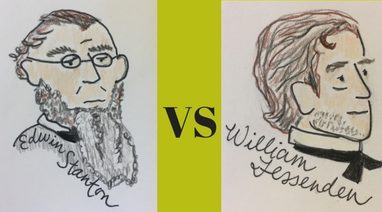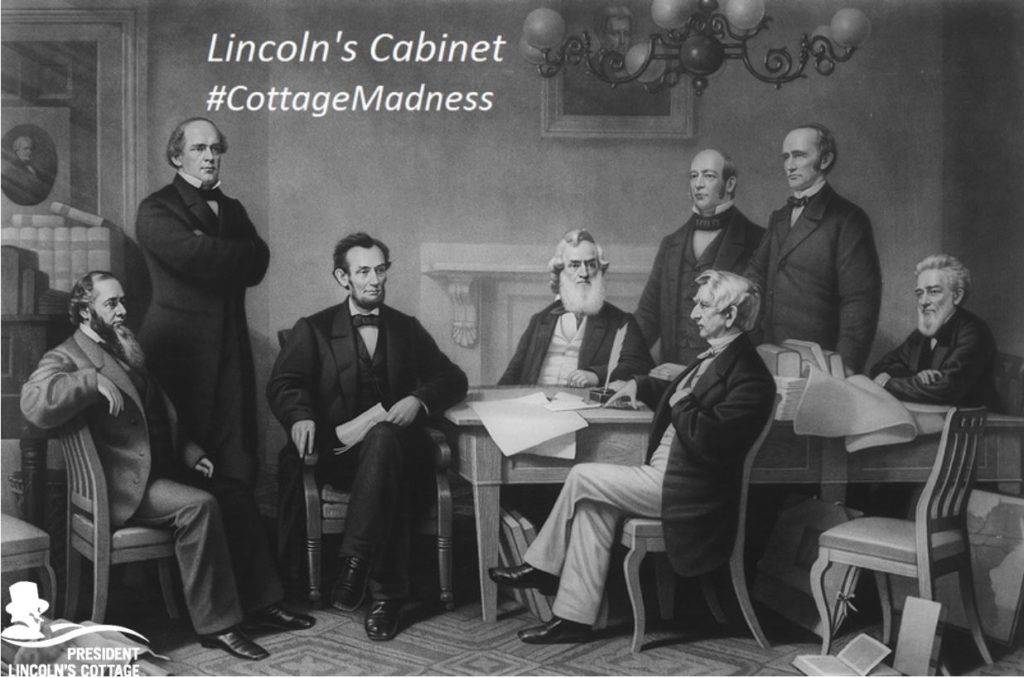Last year we unveiled #CottageMadness, where we pitted 16 people against each other to determine who had the Best Civil War Name. (Congrats again to PLEASANT UNTHANK.) As the 2018 NCAA basketball tournament kicks off, we’re doing it again, but narrowing our focus. This year, we’re asking you to decide who the “Best” member of Lincoln’s cabinet was!
A couple points of clarification. First, Lincoln’s cabinet had 15 official members during his administration. We nixed Hugh McCollough who only served for a month before Lincoln’s assassination. To get it back up to 16, we included both John Hay and John Nicolay, Lincoln’s Private Secretaries. While technically neither held Cabinet-level posts confirmed by the Senate, they certainly played a key role in the Lincoln Administration, similar to modern day Chiefs of Staff.
Now, what criteria should you vote on these distinguished public servants? That’s up to you. Do you go with the cabinet members who were the most successful at their jobs? Who had the best name? Who had the best beard? The choice is yours.
Here’s the time table for voting:
Round 1: Friday 3/16 until 11:59 PM
Quarterfinal: Monday 3/19 until 11:59 PM
Semifinal: Tuesday 3/20 until 11:59 PM
Championship: Wednesday 3/21 until 11:59 PM
The winner will be announced in our e-newsletter, the Proclamation, which will come out Thursday, 3/22. To sign up, and find out who claims all the glory, email [email protected] to be added to our list!
You can download the full bracket here: Lincoln Cabinet Members Round 1. Here’s the link to vote on our the first round.
Round 1 Matchups
1 Secretary of State William Seward vs. 16 Attorney General James Speed
Our No. 1 seed appeared to be the favorite for the Republican Nomination for President in 1860 — until a lanky Illinoisan said otherwise. Even when he was nominated as Secretary of State, he attempted to be the power behind the throne, before Lincoln told him nothing doing. But soon he became a great ally of Lincoln’s and served as Secretary of State through the rest of his term (plus Andrew Johson’s tenure). James Speed lived up to his name: he only served as Lincoln’s Attorney General for five months from December 1864-April 1865. He originally was from Kentucky and helped keep that state in the Union. But will it be enough to topple the man who bought Alaska?
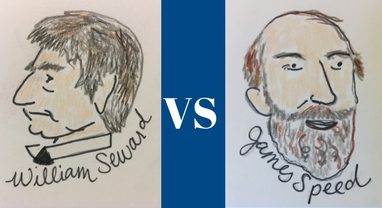
8 Secretary of the Interior Caleb Smith vs. 9 Vice President Andrew Johnson
You might wonder why we didn’t seed the Vice President who became President on Lincoln’s death higher. Well for one he only served in the Lincoln Cabinet for six weeks before becoming President. Plus, he was allegedly drunk for his own inauguration. That’s not great preparation for a high seed. Caleb Smith (Secretary from 1861-1862) also was pretty so-so. He was the first person from Indiana to hold a cabinet-level position, but he also was opposed to the Emancipation Proclamation at first. Strangely, his body is currently missing from its supposed grave.
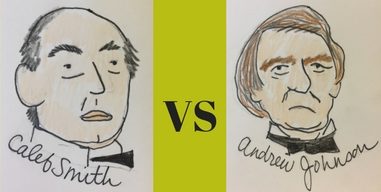
5 Postmaster General Montgomery Blair vs. 12 Private Secretary John Nicolay
In the basketball version of March Madness, 12 seeds beat 5 seeds over 1/3 of the time. Will that happen here? German-born John Nicolay served as Lincoln’s personal secretary along with 10 seed John Hay, and later the two of them wrote a definitive biography of Lincoln. Neat fact: Arnold Schwarzenegger voiced him in a 1992 documentary on Lincoln. Meanwhile, Postmaster General Montgomery Blair served from 1861-1864 in Lincoln’s cabinet, and urged the President to take a strong approach to the South. He also called for the First International Postal Conference, which took place in Paris while he was Postmaster General.
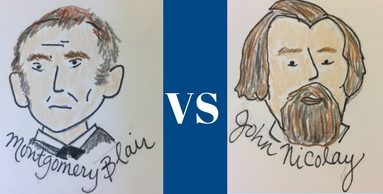
4 Secretary of the Navy Gideon Welles vs. 13 Postmaster General William Dennison
Gideon Welles was one of just two official cabinet members who served for the duration of Lincoln’s presidency (the other being Seward). Nicknamed “Neptune” for obvious reasons (check out that beard), he increased the Union navy by tenfold during the war, and played a key role in the implementation of the Anaconda Plan. Dennison took over from Montgomery Blair in 1864, and served through the rest of Lincoln’s term. Upon Blair’s resignation, Lincoln wrote him “Mr. Blair has resigned, and I appoint you Post-Master General. Come on immediately.” Unfortunately, he missed his train and so he didn’t come immediately.
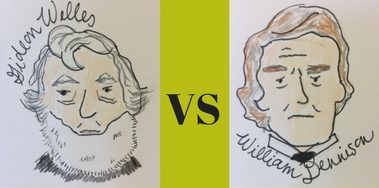
6. Attorney General Edward Bates vs. 11. Secretary of War Simon Cameron
Even more impressive than Caleb Smith being the first Indianan to serve in the cabinet, Missourian Edward Bates was the first cabinet member from west of the Mississippi River. But outside of that he wasn’t impressive, as he disagreed with Lincoln on many issues surrounding emancipation, including the enlistment of African American troops. Yet, he’s still favored in this 6-11 matchup. Simon Cameron was so corrupt he was the first cabinet member of Lincoln’s to be removed, as Lincoln kicked him upstairs — to Russian Ambassador, in January 1862. (Thaddeus Stevens once said to Lincoln that “I don’t think that [Cameron] would steal a red hot stove.” After Cameron demanded Stevens retract the remark, he said “I believe I told you he would not steal a red-hot stove. I will now take that back.”)
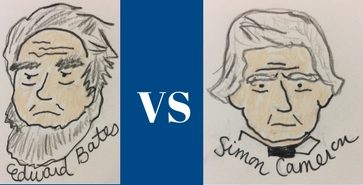
3 Secretary of the Treasury Salmon P. Chase vs. 14 Secretary of the Interior John P. Usher
Like many people in this bracket, Salmon P. Chase thought he was going to be the first Republican President. So much for that idea. Nonetheless, Lincoln recruited Chase, a radical on slavery, to his cabinet, and he served for four years. As the Secretary of the Treasury, he financed the Union’s war effort, establishing a national banking system, issuing paper money, and implementing the first national income tax, passed by Congress. Later, he resigned and Lincoln subsequently appointed him Supreme Court Chief Justice. John Palmer Usher perhaps should be a higher seed since as Assistant Secretary of the Interior, he did a lot of the heavy lifting under Caleb Smith. Perhaps the most interesting factoid about him is that he accompanied Lincoln to Gettysburg and was on the speakers’ platform with him.
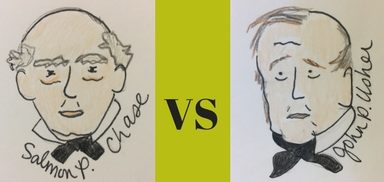
7 Vice President Hannibal Hamlin vs. 10 Private Secretary John Hay
Hannibal Hamlin, besides having a great name, is maybe one of the more underappreciated “What Ifs” in American History. Hamlin was nominated fairly easily at the 1860 Republican National Convention, and served well for four years. Hailing from Maine, he was pro-Emancipation Proclamation and pro-arming African American troops. However, he played a small role in the administration (as was typical of Vice Presidents then), and was replaced by Andrew Johnson on the ticket in 1864. While that proved a smart choice in the polls, who knows what would have happened if Hamlin had succeeded Lincoln instead of Johnson. Maybe Reconstruction would have been much different with him in charge? Jon Hay got his job as Private Secretary to Lincoln while working in his uncle’s law practice — which happened to be next door to Lincoln’s in Springfield. His main duty was responding to the President’s correspondence. He was at Lincoln’s bedside when the President died, and later served as Secretary of State under McKinley.
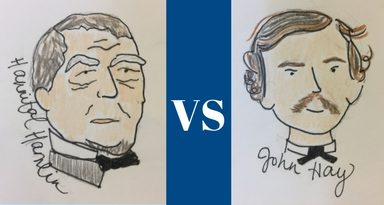
2 Secretary of War Edwin Stanton vs. 15 Secretary of the Treasury William P. Fessenden
William Fessenden was another Mainer who rallied support behind Lincoln. Less radical than Chase, he was a natural choice to take over when Chase resigned in 1864. He himself resigned the next March when he accomplished all he had wanted to do. In short, he was a fine Secretary, if a bit too brief to have made that much of an impact. Edwin Stanton on the other hand made an invaluable impact on the Union war effort, organizing all elements of the military operations under Lincoln’s command. Nicknamed “Mars” just as Gideon Welles was referred to as Neptune, Stanton could be overbearing, micromanaging and controversial. But he vigorously enforced Lincoln’s orders, and was also responsible for taking charge of the manhunt for John Wilkes Booth after Lincoln’s Assassination.
